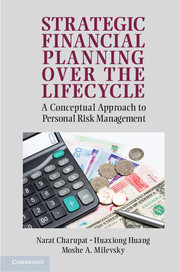Book contents
- Frontmatter
- Contents
- Acknowledgments
- 1 Introduction and Motivation
- 2 Mathematical Preliminaries – Working with Interest Rates
- 3 Personal Balance Sheet and Human Capital
- 4 Consumption Smoothing and Optimal Savings
- 5 Debts, Loans, and Mortgages [Canadian Content]
- 6 Personal Income Taxes [Canadian Content]
- 7 Risk, Utility, and Insurance
- 8 Mortality Risk and Life Insurance
- 9 Investment and Diversification
- 10 The Mathematics of Portfolio Diversification
- 11 Housing Decisions
- 12 Pensions and Retirement [Canadian Content]
- 13 Advanced Material: Part I. Continuous Time and the Calculus of Variations
- 14 Advanced Material: Part II. Stochastic Optimal Control and the HJB Equation
- 15 Concluding Thoughts and Next Steps
- Bibliography
- Index
1 - Introduction and Motivation
Published online by Cambridge University Press: 05 June 2012
- Frontmatter
- Contents
- Acknowledgments
- 1 Introduction and Motivation
- 2 Mathematical Preliminaries – Working with Interest Rates
- 3 Personal Balance Sheet and Human Capital
- 4 Consumption Smoothing and Optimal Savings
- 5 Debts, Loans, and Mortgages [Canadian Content]
- 6 Personal Income Taxes [Canadian Content]
- 7 Risk, Utility, and Insurance
- 8 Mortality Risk and Life Insurance
- 9 Investment and Diversification
- 10 The Mathematics of Portfolio Diversification
- 11 Housing Decisions
- 12 Pensions and Retirement [Canadian Content]
- 13 Advanced Material: Part I. Continuous Time and the Calculus of Variations
- 14 Advanced Material: Part II. Stochastic Optimal Control and the HJB Equation
- 15 Concluding Thoughts and Next Steps
- Bibliography
- Index
Summary
This book grew out of the deep frustration two of the three authors have experienced for many years, trying to teach a practical yet rigorous course on personal – in contrast to corporate or investment – finance, to undergraduate and graduate students at Canadian business schools. Although there are many college-level textbooks that discuss the tactical aspects of personal finance – nuggets such as: credit card debt is bad; reduce fees on mutual funds; regular saving is important; have a budget; and so on – we have not come across a textbook that integrated all these disparate concepts into a conceptual or strategic framework for financial decision making, based on sound economic principles.
For the most part, personal finance is being taught as a collection of standalone facts about “smart” money management. Most existing textbooks are written assuming a (very) basic background in mathematics on the part of the student, which limits the financial and economic level at which such a course can be delivered and the material discussed. Moreover, in today's Google and YouTube world, curious students could obtain more relevant, accurate, and up-to-date information about most (if not all) of the products that are part of the personal financial toolkit. In our opinion, a textbook that allocates most of its pages to the tactical aspects of financial planning, such as explaining how to read a credit card statement or how to get a copy of your credit report from your local credit bureau, or how to open up a brokerage account, is not advanced enough for a third or fourth year course in a business school.
- Type
- Chapter
- Information
- Strategic Financial Planning over the LifecycleA Conceptual Approach to Personal Risk Management, pp. 1 - 3Publisher: Cambridge University PressPrint publication year: 2012



